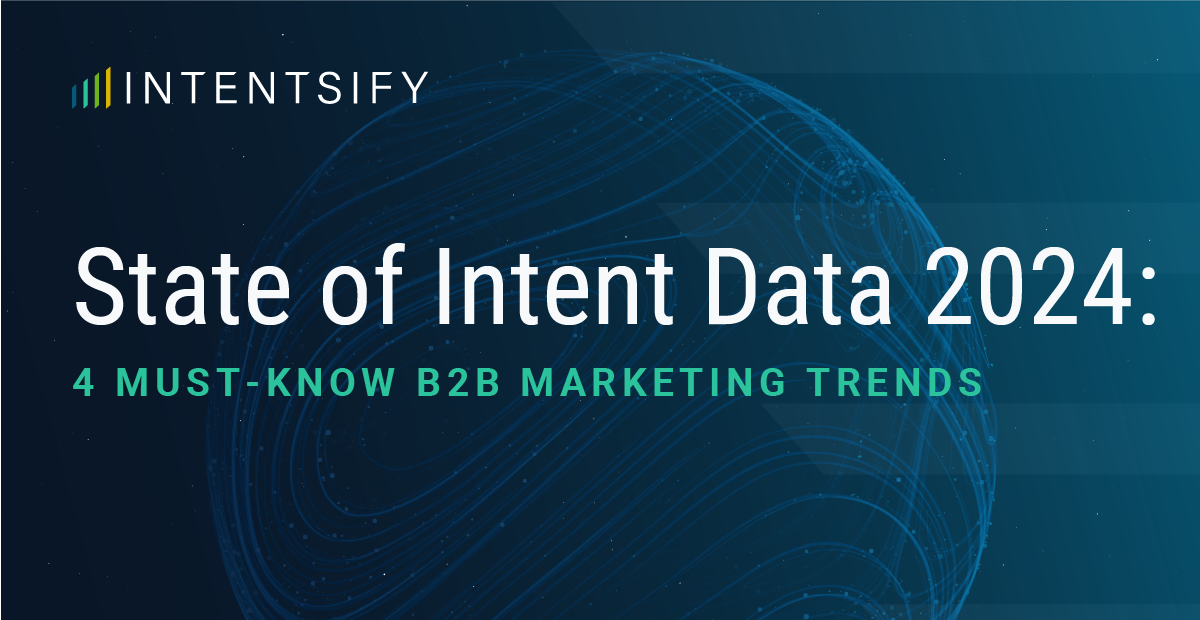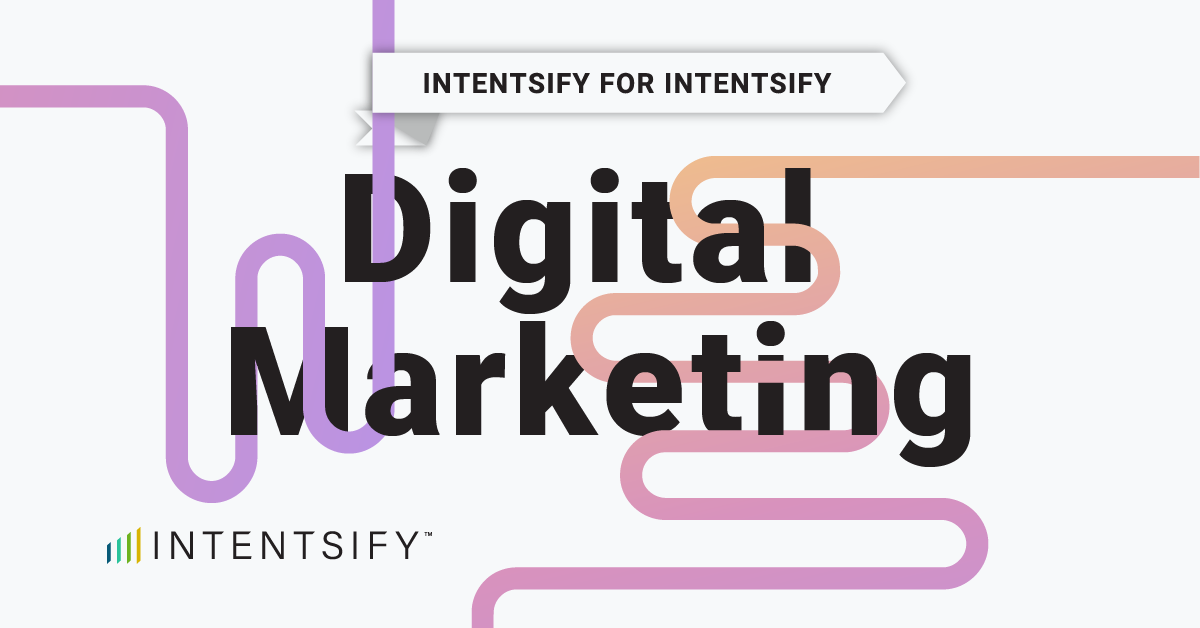Account-based marketing (ABM) platforms and intent data are solutions that have made their way into every B2B marketer’s vocabulary. Both have played a pivotal role in enabling marketing and sales teams to effectively identify, prioritize, and engage with their target audiences throughout the buyer’s journey.
But what are the differences between ABM platforms and intent data solutions? What are the primary features and use cases of each? Do you need both, and what are some considerations when determining what will be best for your organization?
In this blog post, we break it all down to help you understand how best to leverage each technology to drive better outcomes for your B2B organization.
What Is an Account-Based Marketing (ABM) Platform?
To understand what an ABM platform is, it’s important to first understand what ABM is. Gartner provides a clear, concise definition:
Account-based marketing (ABM) is a go-to-market strategy (GTM) targeting certain accounts with a synchronized, continuous set of marketing and sales activities. ABM activities engage those accounts and individuals through all stages of the buying journey.
By focusing GTM teams’ time, energy, and resources on accounts most likely to both buy and generate a high customer-lifetime value (CLV), ABM supports efficient growth. The key to doing this well is personalizing the engagement strategy for each account (or group of similar accounts) to meet their specific needs. That’s where ABM platforms come in.
Key features and capabilities of ABM platforms include:
- Account identification
- Account segmentation and targeting
- Data management and enrichment
- Account-based personalization
- Multi-channel orchestration and automation
- Large integration and partnership ecosystem
- Predictive analytics and full-funnel reporting
While these are key characteristics of ABM platforms, it’s worth mentioning that intent data plays an important role in the functionality of these capabilities. Because intent data can reveal each target account’s research behaviors, interests, and journey stage, it helps inform the strategies and tactics tied to these capabilities (specifically regarding account identification, segmentation, targeting, and personalization).
What Are the Primary Use Cases of ABM Platforms?
ABM platforms offer a wide range of use cases to help marketing and sales teams target and engage with their target accounts more effectively.
These use cases include:
- Identification of in-market buyers
- Mapping individuals to buying groups
- Personalizing sales and marketing engagements
- Account-based advertising
- Sales and marketing alignment
- Buyer’s journey tracking
- ROI measurement
What Is an Intent Data Solution?
Intent data solutions offer valuable insights into the behavior, interests, and readiness of prospects and customers to buy, and are essential to modern marketing and sales strategies. Intent data refers to signals generated from a company’s online research and engagement activities. By surfacing each target account’s interests and where they are in the buyer’s journey, intent data providers help B2B organizations prioritize accounts and understand which channels and messaging they should use to engage them.
It’s important to note that intent data solutions vary greatly by sources, tracking methodologies, and scoring types, each having its own strengths and weaknesses. Learn about the different intent data types and the pros and cons of each data source in this blog post.
Key features and capabilities of leading intent data providers include:
- Real-time monitoring of intent signals
- Multi-source aggregation (for breadth of coverage)
- Intent-signal synthesis (for granularity of account intelligence)
- Intent-based segmentation
- Noise filtering (I.e., false-positive signal prevention)
- Keyword and topic tracking
- Intent model customization (e.g., weighted topics and keywords)
- Trend-, volume-, and rank-based intent scoring
- Buying-stage identification
- In-depth analytics and reporting
- Multi-channel intent activation
What Are the Primary Use Cases of Intent Data Providers?
Intent data providers focus on the collection, analysis, delivery, and often the activation of intent insights, supporting many use cases that help B2B organizations improve their GTM effectiveness.
These use cases include:
- Target-account list (TAL) development
- Messaging and content selection
- Account scoring and qualification
- Sales prioritization
- Competitive intelligence
- Customer-churn prevention
- Customer upsell/cross-sell
- Market intelligence
What Are the Key Differences Between ABM Platforms and Intent Data Providers?
Account Focus and Reach
This should come as no surprise, but ABM platforms are built for organizations that have already implemented or would like to implement an ABM strategy. ABM platforms help companies identify and engage with the highest-value accounts in their TAL and often place an emphasis on targeting prospects that are in-market to buy.
Intent data solutions can play a key role in supporting your ABM strategy but can also be used if you don’t have an ABM strategy in place. These solutions can also uncover in-market buyers, but the use cases span the entire customer lifecycle, from awareness all the way to post-purchase. Intent data can help you identify accounts that are not yet in a buying cycle, which enables you to cast a wider net and can give you a competitive advantage if you start engaging with these accounts before your competitors do. By identifying these accounts early on, marketers can nurture these accounts with early-stage content (e.g., blog posts, research reports, eBooks) to educate them about potential solutions to their challenges and prime them for sales engagement.
Intent Data Capabilities
To be clear, most ABM platforms now offer intent data as it has become table stakes for ABM. However, because these platforms don’t specialize in intent data, they often lack the breadth and depth of intent signals and tracking methodologies that some intent data providers offer. In fact, many ABM platforms rely on partnerships with intent data vendors to strengthen their capabilities.
In fact, providers focused solely on intent data (as opposed to ABM platform providers) often deliver far more robust intent intelligence. For example, Intentsify’s Precision Intent aggregates its signals from a minimum of five sources and customizes models to each users’ unique business needs. Moreover, due to their greater intent data focus and expertise, intent data providers can be quite beneficial when it comes to educating and supporting users.
Analytics and Reporting
ABM platforms offer a wide range of features and capabilities including predictive analytics and robust integrations. By integrating with many systems, ABM platforms enable you to have a complete view of the entire buyer’s journey, including sales engagement activities and opportunity stage—providing greater insight into bottom-of-the-funnel activities.
While intent data providers surface signals that suggest where accounts are in the buyer’s journey, these signals are early indicators of interest and do not always demonstrate an account’s readiness to buy. However, because these signals are generated as soon as the account exhibits research behavior, this allows you to engage with the buying group earlier in the funnel. It’s also important to note that the purpose of intent data was never to replace sales qualification. If approached this way, it can result in the inflation of early-stage pipeline and low opportunity win rates.
Do I Need Both an ABM Platform and an Intent Data Provider?
As discussed in this blog post, each technology has its unique strengths that complement the other. When both an ABM platform and intent data solution are leveraged through an integrated GTM strategy, the benefits are greater than the use of each alone. Additionally, the more sources and types of intent data you have at your fingertips, the more comprehensive and powerful your insights—and the strategies that are fueled by these insights —will be.
However, it’s important to consider the time and resources available to dedicate to the implementation and management of these tools. ABM platforms tend to be difficult to implement. They involve much customization and standing them up can be time-consuming and resource intensive. On the other hand, certain campaign-based intent solutions are offered as a managed service, allowing more resource-strained teams to generate value quicker and easier.
Another factor is strategy. ABM platforms require a pre-existing level of sales-marketing alignment to maximize its value, whereas intent solutions can cater to sub-functional needs, such as intent-driven content syndication, all the way up to cross-functional strategies involving multiple teams in the organization.
To sum it up, ABM platforms can be a great investment when you have the time, resources, and internal alignment to execute your strategies effectively, but they are a much bigger lift, requiring more resources, onboarding, and typically much more investment budget than intent solutions. When determining which solutions will be best for your organization, it’s important to evaluate your current strategies, budget, team capacity, and business goals.
Interested in learning more about the intent data provider landscape? Check out The Forrester Wave™: B2B Intent Data Providers, Q2 2025 report and learn why Intentsify was recognized as a Strong Performer.






